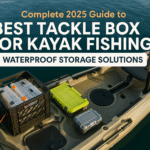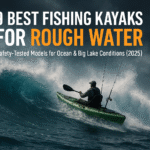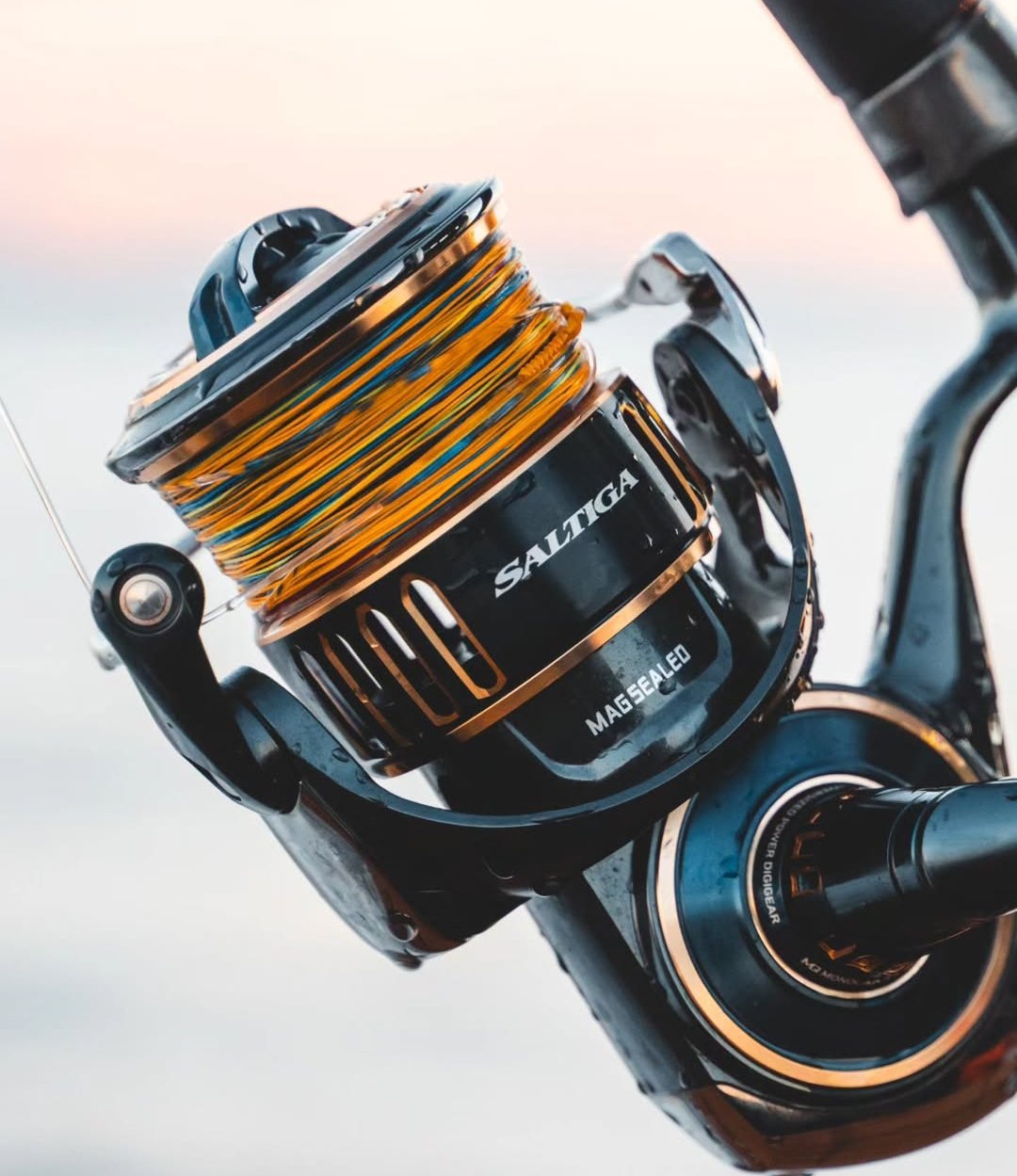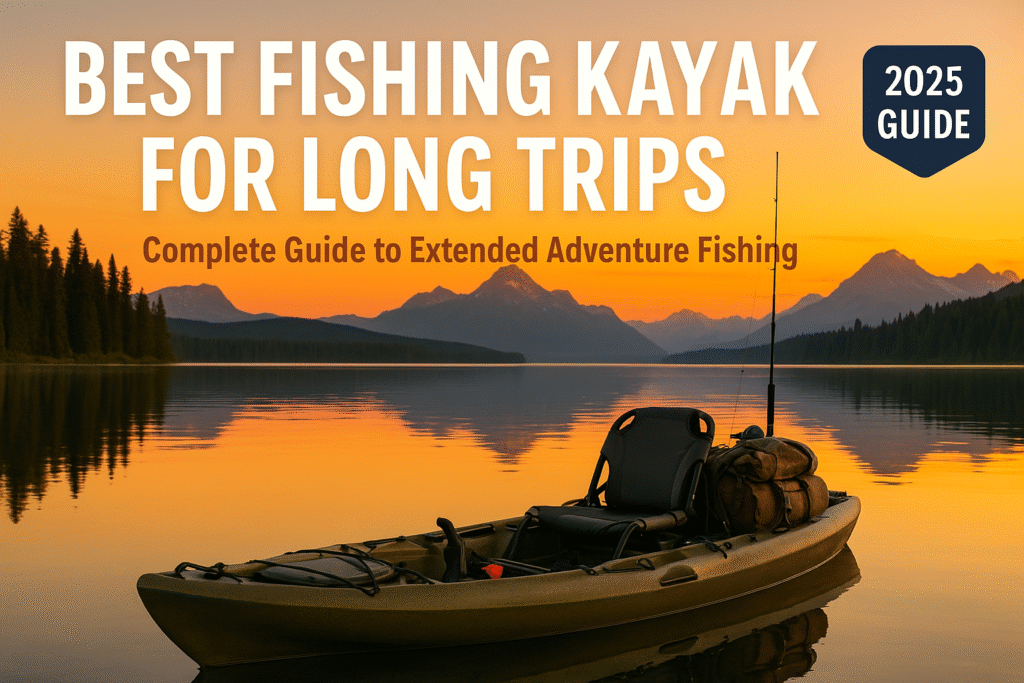
Gliding across a pristine lake at dawn, a mist rising from the water as you cast your line into untouched fishing spots miles from any boat ramp—it’s a dream for any angler. A three-day fishing adventure requires a vessel that’s more than just a boat; it’s a trusted partner that makes long-distance kayak fishing a reality. I’ve spent countless hours on extended fishing trips, and I can tell you from experience, the wrong vessel can turn your dream into a nightmare. That’s why choosing the best fishing kayak for long trips is essential. It’s the difference between a journey of comfort and one of frustration.
Key Takeaways
- Storage capacity is king – Look for kayaks with at least 400+ pounds capacity and multiple sealed hatches for multi-day trips
- Comfort features matter more than speed – Adjustable seats, foot pegs, and ergonomic design prevent fatigue on 8+ hour days
- Pedal-drive systems outperform paddles for covering long distances while keeping hands free for fishing
- Stability trumps speed – Wide, stable platforms (32″+ beam) let you stand, stretch, and fish comfortably all day
- Essential features include rod holders, tackle storage, anchor systems, and mounting points for electronics
Frequently Asked Questions (FAQs) - Q1. How long should a kayak be for an extended fishing trip?
- Generally, a longer kayak (12 feet or more) is preferred for long trips. Longer kayaks track better (stay on a straight course), are faster, and have more storage space. While shorter kayaks are more maneuverable in tight spaces like streams, they require more effort to paddle over long distances.
- Q2. How do I pack a kayak for an overnight or multi-day trip?
- Strategic packing is key. Place heavier items like food and water low in the kayak and as close to the center as possible to maintain a stable center of gravity. Distribute the remaining gear evenly from front to back, using small dry bags to fit into the hatches and bow/stern sections of the hull. Keep essential items like a first-aid kit, snacks, and a headlamp in an easily accessible deck bag.
- Q3. Are sit-on-top or sit-inside kayaks better for long trips?
- For fishing, a sit-on-top kayak is generally the better choice. They offer more stability, easier access to gear, and the ability to stand up and cast. They also drain water through scupper holes, making them less likely to fill up if you take on a wave. Sit-inside kayaks are faster and more protective from the elements but can be more difficult to re-enter if you capsize and have less accessible storage for fishing gear.
- Q4. What is a good budget-friendly option for a long-distance fishing kayak?
- While top-tier models can be expensive, many mid-range kayaks offer an excellent balance of features for long trips. Brands like Perception, Wilderness Systems, and Old Town offer kayaks with good stability, storage, and comfort for a more accessible price point. Look for a durable polyethylene hull, a comfortable seat, and ample storage options.
- Q5. What are the essential safety items for a multi-day kayak fishing trip?
- Safety should be your top priority. Always carry a personal flotation device (PFD), a marine VHF radio or satellite communication device, a whistle, a powerful light, and a first-aid kit. File a float plan with someone on shore, and be aware of weather forecasts and water conditions.
Understanding Long-Distance Kayak Fishing Requirements
When I first started planning extended kayak fishing trips, I quickly learned that not all fishing kayaks are created equal. A kayak that’s perfect for a quick morning session at your local pond might leave you miserable – or worse, unsafe – on a multi-day adventure.
What Makes a Kayak Suitable for Extended Trips?
The best fishing kayak for long trips needs to excel in several critical areas:
Storage Capacity 📦
Your kayak becomes your mobile basecamp. You’ll need space for:
- Multiple days of food and water
- Camping gear (if overnighting)
- Extra tackle and fishing gear
- Safety equipment
- Electronics and batteries
Comfort and Ergonomics 🪑
Spending 8-12 hours in a kayak demands superior comfort:
- High-back seats with lumbar support
- Adjustable foot pegs
- Adequate legroom for stretching
- Stable platform for standing breaks
Tracking and Efficiency 🚣
Long-distance paddling requires:
- Good hull design for straight tracking
- Efficient glide to reduce effort
- Optional pedal or motor compatibility
- Rudder or skeg for wind management
What Features Make a Kayak the Best Fishing Kayak for Long Trips
1. Hull Design and Stability
The hull is the foundation of your long-distance fishing platform. For extended trips, I recommend looking for:
Pontoon or Catamaran-Style Hulls
These designs offer:
- Maximum stability for all-day fishing
- Better weight distribution
- Ability to stand comfortably
- Reduced fatigue from constant balancing
Length Considerations
Longer kayaks (13-16 feet) provide:
- Better tracking on open water
- More storage space
- Improved speed and efficiency
- Greater load capacity
2. Propulsion Systems
While a paddle kayak can work for long trips, modern propulsion systems make extended adventures much more enjoyable:
Pedal Drive Systems 🚴
- Hands-free operation for fishing
- 3-4x faster than paddling
- Less upper body fatigue
- Better for covering distance
Motor Compatibility 🔧
- Trolling motor mounts
- Battery storage areas
- Reinforced transoms
- Wire management systems
3. Storage Solutions
A touring kayak might have basic storage, but a proper long-trip fishing kayak needs:
Multiple Sealed Hatches
- Front hatch for camping gear
- Center console for tackle
- Rear well for coolers/crates
- Side pockets for quick access
Bungee Systems and Tie-Downs
- Secure gear on deck
- Quick access to frequently used items
- Flexibility for odd-shaped equipment
What Kayak Is Best for Extended Kayak Fishing Trips in 2025?
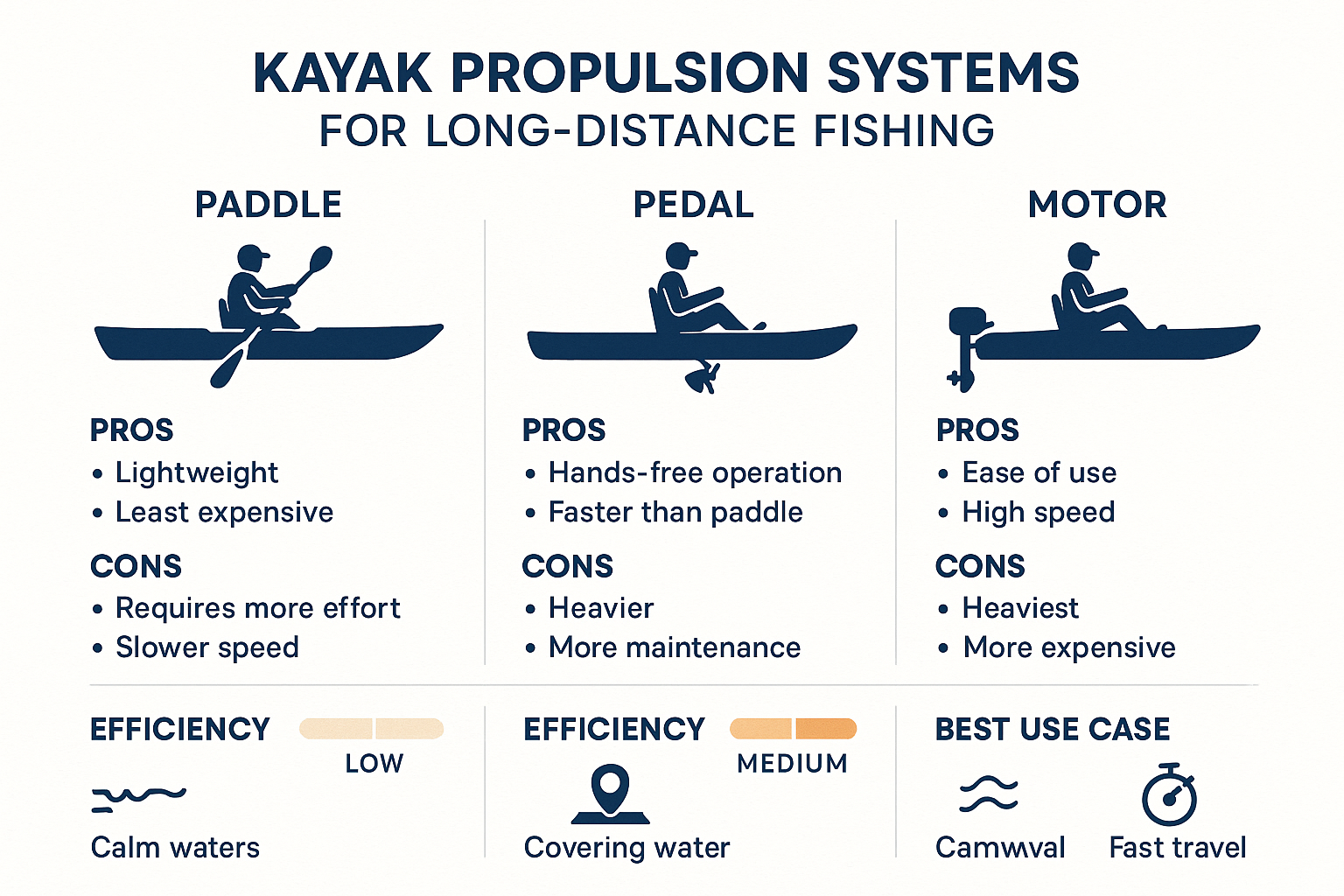
After extensive testing and research, here are my top picks for the best fishing kayaks for 2025 long-distance adventures:
1. Old Town Sportsman AutoPilot 136 – Best Overall
The Old Town AutoPilot series revolutionizes long-distance kayak fishing with its motorized Minn Kota system.
Pros:
- Spot-Lock GPS anchoring
- Hands-free operation
- 45-pound thrust motor
- Massive storage capacity
Cons:
- Premium price point
- Heavy for car-topping
- Requires battery maintenance
2. Hobie Mirage Pro Angler 14 360 – Best Pedal Kayak
This pedal kayak sets the standard for human-powered long-distance fishing.
Features:
- 360-degree rotating seat
- MirageDrive 360 with reverse
- Horizontal rod storage
- Standing platform design
3. Jackson Kayak Knarr FD – Best Budget Pedal Option
Jackson Kayak delivers incredible value with their flex-drive pedal system.
Highlights:
- Removable pedal drive
- Comfortable elevated seat
- Multiple rod holders
- Great stability at 34″ wide
4. Wilderness Systems ATAK 140 – Best Sit-On-Top Kayak
This sit-on-top kayak balances performance with fishing features perfectly.
Key Features:
- AirPro MAX seat system
- Flexible storage options
- Phase 3 AirPro seating
- Excellent tracking
5. Advanced Elements StraitEdge Angler Pro – Best Inflatable Fishing Kayak
Don’t overlook inflatable fishing kayaks for long trips – modern designs are incredibly capable.
Benefits:
- Easy transportation
- Surprising durability
- Good tracking with skegs
- Compact storage
What Essential Gear Do You Need for an Extended Kayak Fishing Trip?
Beyond choosing the right kayak, proper gear selection makes or breaks your long-distance adventure:
Navigation and Safety Equipment 🧭
Must-Have Items:
- Marine GPS with backup
- VHF radio or satellite communicator
- Comprehensive first aid kit
- Signal devices (flares, mirror, whistle)
- Quality landing net for safe fish handling
Comfort Upgrades
Game-Changing Additions:
- Gel seat cushions
- Lumbar support pillows
- Sun shade/bimini
- Hydration systems
- Insulated fish bags
Fishing-Specific Gear
Long-Trip Essentials:
- Multiple rod setups
- Compact tackle organization
- Anchor trolley system
- Fish finder with side imaging
- Waterproof storage for electronics
How Do I Plan a Multi-Day Kayak Fishing Adventure?
Route Selection and Preparation
Successful long trips start with thorough planning:
- Study Your Waters 📍
- Mark potential camping spots
- Identify hazards and obstacles
- Plan bailout points
- Check weather patterns
- Distance Planning
- Average 2-3 mph cruising speed
- Plan for 15-20 miles per day max
- Factor in fishing time
- Build in rest days
- Weather Considerations 🌤️
- Monitor extended forecasts
- Understand wind patterns
- Plan for sudden changes
- Know safe harbor locations
Physical Preparation
Long-distance kayak fishing demands physical readiness:
Training Tips:
- Build core strength
- Practice proper paddling technique
- Gradually increase trip distances
- Stretch regularly on the water
How to Choose the Best Fishing Kayak for Long Trips: A Buyer’s Guide

Find Your Perfect Long-Trip Fishing Kayak
Recommended Kayaks
Pros
- Hands-free fishing
- Covers distance effortlessly
- Massive storage capacity
Cons
- High price point
- Heavy (120+ lbs)
- Battery maintenance required
Pros
- Incredible stability
- Efficient pedal system
- Versatile seating options
Cons
- Expensive
- Wide for narrow passages
- Complex drive system
Pros
- Great value for money
- Stable fishing platform
- Easy drive removal
Cons
- Limited hatch storage
- Basic seat adjustment
- Slower than premium options
Pros
- Excellent tracking
- Comfortable all-day seat
- Versatile rail system
Cons
- Paddle-only propulsion
- Heavy for its class
- Limited standing ability
Pros
- Affordable price
- Stable design
- Good storage options
Cons
- Limited for multi-day trips
- Basic features
- Slower hull design
No kayaks match your selected criteria. Try adjusting your filters.
How Do I Maintain and Care for a Kayak Used on Long Trips?
Your investment in a quality fishing kayak deserves proper care, especially when subjecting it to extended use:
Pre-Trip Inspection Checklist ✅
Hull and Hardware:
- Check for cracks or damage
- Tighten all screws and fittings
- Lubricate moving parts
- Inspect rudder/skeg cables
Storage Compartments:
- Test hatch seals
- Clean drainage channels
- Check bungee cord integrity
- Verify dry bag condition
Post-Trip Maintenance
Essential Steps:
- Rinse Thoroughly – Remove salt and debris
- Dry Completely – Prevent mold and mildew
- Inspect for Damage – Address issues immediately
- Lubricate Systems – Keep pedal drives smooth
- Store Properly – Out of direct sunlight
What Are the Top Safety Considerations for Extended Kayak Fishing?
Long-distance trips multiply both rewards and risks. Here’s how to stay safe:
Communication and Emergency Planning 📡
Essential Safety Gear:
- Primary Communication: VHF radio with DSC
- Backup: Satellite messenger (InReach, SPOT)
- Visual Signals: Flares, mirror, strobe light
- Sound Signals: Air horn, whistle
Float Plan Essentials
Always file a detailed float plan including:
- Launch and takeout locations
- Daily mileage goals
- Camping/rest locations
- Emergency contact info
- Expected return time
Weather Monitoring
Long trips demand vigilant weather awareness:
- Check extended forecasts daily
- Monitor real-time conditions
- Understand local weather patterns
- Know when to stay off the water
What Are the Best Advanced Techniques for Long-Distance Kayak Fishing?
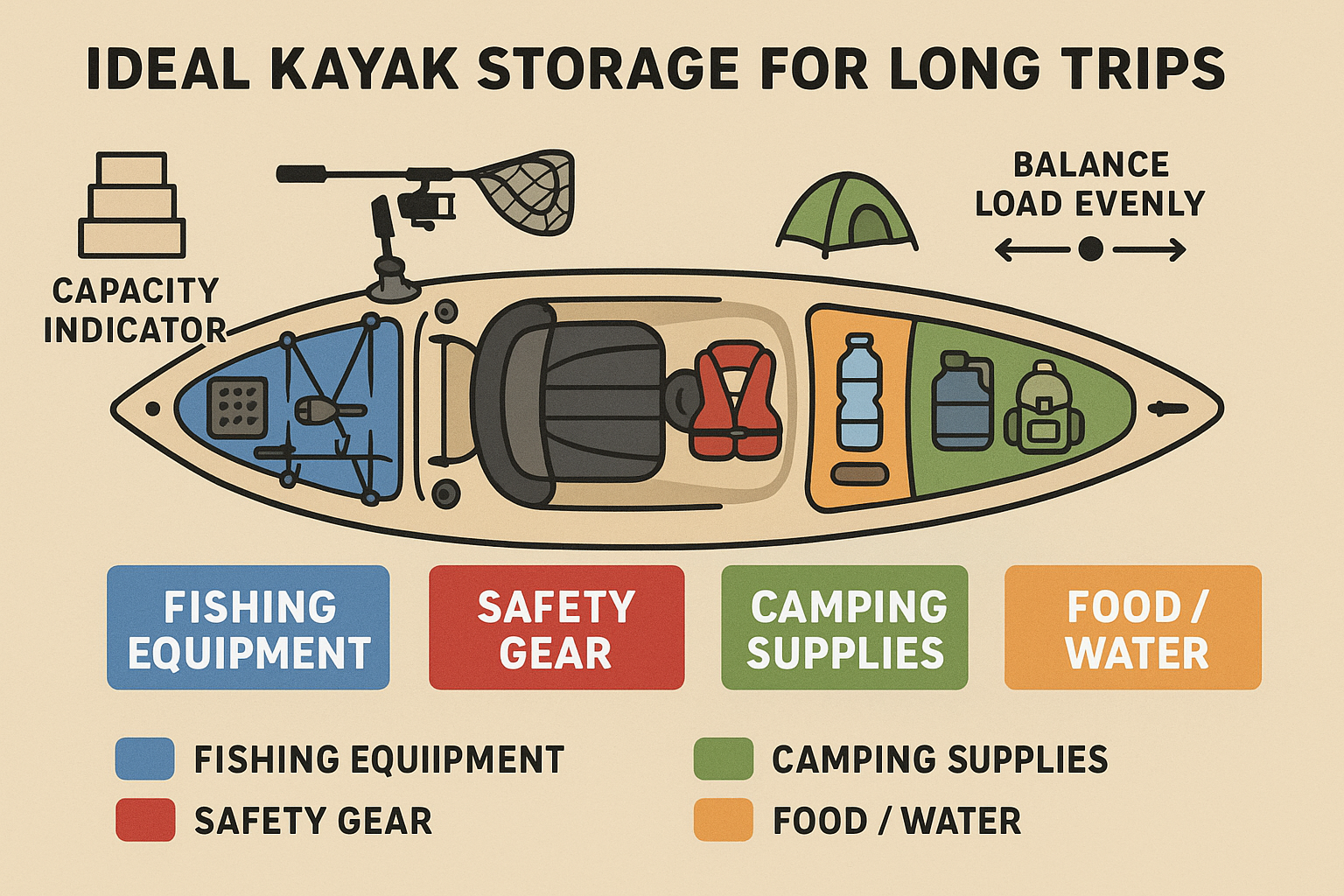
Energy Conservation Strategies 💪
Efficient Paddling:
- Use torso rotation, not just arms
- Maintain steady cadence
- Take advantage of currents
- Draft behind wind breaks
Smart Fishing Approach:
- Anchor in productive areas
- Use drift techniques
- Plan fishing times around travel
- Minimize unnecessary movement
Navigation Tips for Extended Trips
Essential Navigation Skills:
- GPS Proficiency – Mark waypoints and tracks
- Chart Reading – Understand depths and hazards
- Natural Navigation – Use landmarks and sun position
- Tide/Current Planning – Work with nature, not against it
Are Sit-On-Top or Sit-Inside Kayaks Better for Long Fishing Trips?
The difference between fishing kayak and regular kayak becomes crucial for extended adventures:
Sit-On-Top Advantages 🚣
- Easy Entry/Exit – Stretch and swim breaks
- Self-Bailing – No pumping required
- Gear Access – Everything within reach
- Stability – Better for standing and fishing
Sit-Inside Benefits 🛶
- Weather Protection – Stay drier in rough conditions
- Efficiency – Better paddling ergonomics
- Storage Security – Gear stays protected
- Warmth – Better for cold weather trips
What are the Budget Considerations for Long-Trip Kayaks
Initial Investment vs Long-Term Value 💰
Budget Breakdown:
- Entry Level ($800-1,500): Basic features, paddle-only
- Mid-Range ($1,500-3,000): Pedal options, better seats
- Premium ($3,000+): Motor systems, top features
Hidden Costs to Consider:
- Transportation (roof racks, trailers)
- Safety equipment
- Electronics and mounts
- Maintenance supplies
- Storage solutions
Best Budget Options
For anglers on a budget, consider:
- Used Premium Models – Better than new budget kayaks
- End-of-Season Sales – 20-30% discounts common
- Package Deals – Include paddle, PFD, accessories
- Inflatable Options – Modern designs perform well
What Are the Regional Considerations for Planning a Long-Distance Kayak Fishing Trip?

Freshwater vs Saltwater Trips 🌊
Freshwater Advantages:
- Less corrosive environment
- Calmer conditions typically
- More camping options
- Easier navigation
Saltwater Challenges:
- Requires thorough rinsing
- Tides and currents
- Limited freshwater access
- More exposed conditions
Popular Long-Distance Kayak Fishing Destinations
Top Locations:
- Florida Keys – Island hopping paradise
- Boundary Waters – Wilderness fishing
- California Coast – Best kayak fishing lakes in California offer protected alternatives
- Everglades – Backcountry adventures
What Technology and Electronics Are Essential for Extended Kayak Fishing Trips?
Power Management Solutions 🔋
Battery Options:
- Lithium batteries for weight savings
- Solar panels for recharging
- Power banks for electronics
- Dual battery systems for redundancy
Essential Electronics
Must-Have Tech:
- GPS/Chartplotter – Navigation and waypoints
- Fish Finder – Locate structure and fish
- VHF Radio – Emergency communication
- Weather Radio – Real-time updates
- LED Lights – For night fishing safety
How to Train and Prepare for Long-Distance Kayak Fishing Adventures?
Physical Conditioning 🏋️
Training Program:
- Weeks 1-4: Build base endurance
- Weeks 5-8: Add distance and intensity
- Weeks 9-12: Simulate trip conditions
- Final Week: Rest and prepare
Skills Development
Essential Skills to Master:
- Self-rescue techniques
- Navigation without GPS
- Weather interpretation
- Emergency repairs
- First aid basics
Community and Resources
Finding Kayak Fishing Partners 👥
Benefits of Group Trips:
- Shared safety responsibility
- Knowledge exchange
- Cost sharing opportunities
- Enhanced enjoyment
Where to Connect:
- Local kayak fishing clubs
- Online forums and groups
- Guided trip services
- Tournament circuits
Educational Resources
Recommended Learning:
- ACA kayak courses
- Wilderness first aid training
- Navigation workshops
- Local guide services
Environmental Considerations
Leave No Trace Principles 🌿
Responsible Practices:
- Pack out all trash
- Use designated campsites
- Respect wildlife distances
- Minimize shoreline impact
Sustainable Fishing Practices
Conservation Tips:
- Practice catch and release
- Use barbless hooks
- Handle fish properly
- Follow size and bag limits
Conclusion
Choosing the best fishing kayak for long trips is about finding the perfect balance between comfort, capability, and your specific needs. Whether you opt for a high-tech motorized kayak like the Old Town AutoPilot or a reliable pedal-driven workhorse like the Hobie Pro Angler, the key is matching the kayak to your adventure style.
Remember, the best kayak is the one that gets you on the water safely and comfortably. Start with shorter trips to test your setup, gradually building to those dream multi-day adventures. With proper planning, the right equipment, and respect for safety, your fishing kayak becomes a passport to incredible experiences and untouched fishing grounds.
Ready to start your long-distance kayak fishing journey? Begin by assessing your local waters and planning a overnight trip. Test your gear, refine your systems, and build the confidence for longer adventures. The fish of a lifetime might be waiting just beyond your usual range – and now you have the knowledge to reach them safely.
For more specialized information, check out FishMaster Guide’s comprehensive resources on kayak fishing gear and techniques. Whether you’re upgrading from a kids fishing kayak or transitioning from shore fishing, the world of long-distance kayak fishing adventures awaits!

